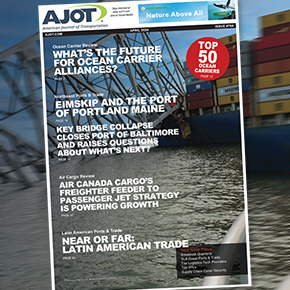What a difference a year makes in the topsy turvy world of shipping. A year ago, the MPV [multi-purpose vessel] and container sectors were riding a wave of optimism resulting from pandemic related issues including a supply chain crisis like we’d never seen before. Now the end of the pandemic has brought back some sense of normalcy in our lives. However, at the same time life as we once knew it will never really be the same.
I must admit, myself and colleagues have had numerous chuckles about how much the term “supply chain” became the topic of the day for most consumers and news personalities during the pandemic. While most had no idea of the definition of supply chain until it had an impact on their daily lives and the shelves started to become sparse.

TMI and MPV Sector Volatility
To any that follow the Toepfer Multipurpose Index (TMI), a forecast of daily charter rates for 12,500 dwt MPV vessels, the last two years has seen tremendous volatility in the index. For the period of April 2021 to April 2022 the index rose a staggering 121% reaching an all-time record in July. We experienced the same type of increases on many commodities during the same period along with significant inflationary pressures. When the supply chain pressures eased and container rates dropped back to historical norms, this is when we experienced a sharp pullback in the TMI. Even with the sharp drop in the TMI since August 2022 the index remains at a healthy level well above both its 10 and 5 year moving averages.
While the current condition of the MPV sector is a bit choppy at the moment the longer range outlook remains quite favorable. Gone are the huge volumes of containers that MPV operators lifted over the last few years. They have made there way back to the containers vessels for the most part and container rates have returned back to more normal levels historically speaking. Inevitably, with lower rates there will be some “poaching” by containership and ro/ro operations — but this is really just the low hanging fruit as rigid schedules, and a lack of operational flexibility (in the case of containerships) precludes any real market penetration. The biggest obstacle moving forward is capacity utilization as the industry will be receiving massive numbers of newbuilds over the next few years.
The same cannot be said about the MPV sector as lack of vessel capacity vs. cargo demand remain challenging. The global fleet over the past decade has experienced a lack of external investment and insufficient internal capital which has stymied growth and fleet renewal. Most MPV and Heavy-lift operators are expected to remain stagnant in respect to overall fleet growth over the next few years. The current MPV fleet for vessels with a combined 100 ton lift capacity is starting to show its age. Less than 5% of the current fleet is from 0-5 years of age. For vessels exceeding 20 years of age the number is almost 17 %. This disparity points to the lack of fleet replenishment over the past decade. Once a vessel surpasses 20 years of service it basically becomes unemployable by most project forwarders, shippers, and EPC’s. It is expected that the current capacity shortfall will continue for the foreseeable future and that project cargo freight will not experience the same drop that containers have experienced.
Focusing our attention on the US project market we find a market that is surging. A recent poll of major project freight forwarders found a consensus opinion that business is clicking on all cylinders.
Wind seems to remain at the forefront due to global green initiatives. The North American continent is literally surrounded by ongoing and planned wind projects for both onshore and landside installation. It remains interesting that windpower was once considered to be our salvation toward a cleaner and healthier planet. However, questions still remain about the actual contribution wind makes to the overall power grid. Global power demand is only forecast to grow in the next couple of decades, so it will require multiple energy sources with LNG, hydrogen and nuclear making up a high percentage of the total resources required to fuel the world. As such a wide range of energy projects could pop up in the near future.
New oil and gas projects are also starting to heat up. This is not just about exploration. Many projects on the books have to do with conversion and upgrades of existing plants. New breakthroughs in carbon capture technology are helping industry to become a better steward for our future. Many of the worlds major oil and energy companies have contributed to these new scientific discoveries on how to convert CO2 into a clean and marketable product.
It’s also important not to overlook the impact that the mining industry has in the project and heavy-lift segment. The carbon neutral world we are now pursuing will require massive amounts of metals and minerals to achieve a net zero world. In addition to the actual extraction of materials we are also seeing the beginning of efforts toward the electrification of mining trucks and other equipment. We are at the very early stages of a complete transformation and need for new replacement equipment.
Finally, the Journal of Commerce recently held their annual Breakbulk Conference in New Orleans. Attendance was in excess of 800 registrants to hear global industry leaders discuss the current health of the Breakbulk and Project sector. What was unique about this conference was how many presentation segments contained the words energy security, vessel emissions, low carbon, no carbon, new ship designs, sustainability, decarbonization, hydrogen, AI, the list went on.
Like it or not the world is changing, and the train has already left the station, so enjoy the ride!





